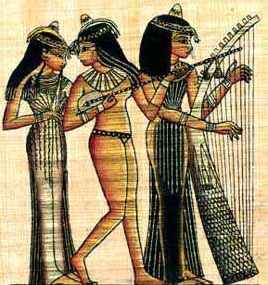Egyptians regarded the status of a woman more or less equal to that of a man. Although the head of the house was the man and only the boys could go to schools, the family was considered incomplete without a woman. Here, it is to be remembered that the status of Egyptian female changed over time and place. Hathor was the patron of Egyptian Women.

Paintings of couples embracing each other are shown and it can we well assumed that Egyptians valued their home and family. Children were loved and cared and this attitude benefited the women. Most women only held the title “Mistress of the House” but a few are recorded as having the title of steward, treasurer and there is one recorded physician.
Marriage was a personal affair for all classes, sharing love and affection between the partners arose naturally out of marriage. No evidence of an actual marriage ceremony has been found so far. But we know that divorces prevailed and adultery was prohibited.
The New Kingdom kings had several wives, although only one bore the title King’s Great Wife and functioned as Queen. Monogamy seems to have been the norm for the rest of the country.
The status of a woman sometimes depended on the class of her male relations. The Egyptian Women of wealthy and noble households led a prosperous life. But her peasant sisters might not have enjoyed the same rights.
Lower and middle-class women were illiterate, though there were a few exceptions. The upper class had a higher rate of literate women. Most royal princesses had private tutors.
It is true that a woman became the Pharaoh only during exceptionable circumstances. Women were banned from government post where writing was needed so most were believed to be illiterate. But otherwise, law was equal to the man and women alike.
They were free to go about in public. They could own property, borrow money, sign contracts, initiate divorce, appear in court as a witness, etc. Of course, they were also equally subject to whatever responsibilities normally accompanied those rights.
Marriage and offspring were always desirable, but in some societies wives were simply domestic servants and offspring acquired importance only when they grew up. The extended family concept was present in Ancient Egypt with mothers, daughters, grandmothers, aunts, living together or in close proximity of each other.
Tombs depict Egyptian Women at various occupations such as singers, musicians, dancers, servants, beer brewers, bakers, professional mourners, priestess and the loyal loving wife.
Egyptian women and men gave considerable importance to their beauty and appearance. Even today, Egyptian women are known for their beauty. Tomb paintings depict the owners in the latest fashions in wigs, clothing, and makeup.
Cosmetics were not considered a luxury but a necessity for daily life and many examples of makeup, perfume, and toiletry items are found in tombs.
Women are often shown gazing into a mirror at a banquet or party. Henna was used to dye the hair, nails, and body. Wealthy ladies had female attendants that helped with her daily grooming. Nudity was not a proscribed among Egyptians.
